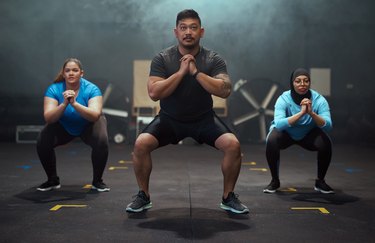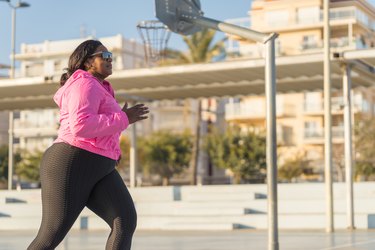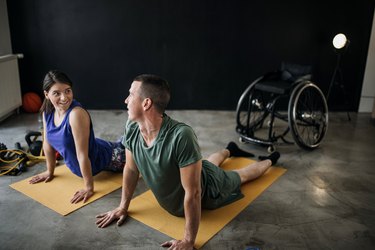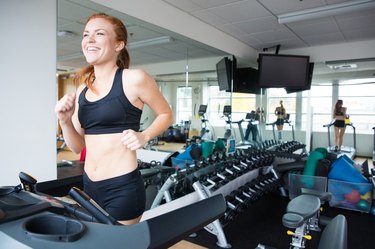
We've all seen workouts or exercises touted as best for women or best for men. You may have also come to know some gender stereotypes at the gym, like women focus on building their glutes and quads, while men just want to pump their biceps and pecs.
All of this might reasonably lead you to wonder: Should females train differently than males? Are there important sex differences in exercise we should be following?
Video of the Day
Video of the Day
According to Mat Kite, CSCS, a certified strength and conditioning specialist and director of education at D1 Training, that's an emphatic no. The notion that certain movements are better for different sexes is starting to fall by the wayside as exercise science tells us that everyone — regardless of their sex and gender identity — can benefit from exercising and moving more overall.
A Note on Language
Here at LIVESTRONG.com, we carefully consider language surrounding sex and gender. We typically avoid language that implies a sex or gender binary in favor of neutral language, such as "assigned female at birth" (AFAB) and "assigned male at birth" (AMAB). We use "gender" when referring to a person's social identity; we use "sex" when referring to biological characteristics.
Most exercise research still categorizes people as men or women, so we're using those terms where they are used by primary sources throughout this article.
More research is needed to more fully understand how biological differences may affect training in people taking hormones as part of gender-affirming care.
Why Sex Shouldn't Dictate Your Workouts
Following workouts or exercises designed for your sex isn't practical because it doesn't take into consideration important factors, such as your individual goals, fitness level or the type of exercises you enjoy.
"Everything in my experience has always been taking an individualized approach to your exercise program," says Chris Gagliardi, CSCS, scientific education content manager for the American Council on Exercise (ACE). "Although genetics and sex can play a role, they don't define you as an athlete."
Even within your sex assigned at birth, no two people will have the same exercise regimen. That's because everyone has different goals, strengths and weaknesses. The truth is when you do exercises or workouts programmed for a certain sex, you're doing a disservice to yourself because it doesn't account for your unique needs.
"There's not really a reason why resistance-training programs for men and women need to be different," says Tracy Schwellenbach, CPT, a certified personal trainer and the medical integration supervisor at the Northwestern Medicine Delnor Health & Fitness Center.
Muscle quality is also not sex-specific, and when you're doing any form of physical activity, people AMAB and AFAB use the same muscles to get the work done. Plus, anyone can progress their workouts in the same way, even though they are working with different weights. Essentially, we all respond to the stimulus of exercise in similar ways, Schwellenbach says.
No matter how you identify, everyone should take a holistic approach to exercise, Kite says. This means training your entire body and doing exercises that work specific muscles or muscle groups.
4 Biological Differences to Consider
Anyone of a similar fitness level can do the same workouts and training plans, but there are some biological differences between those AMAB and AFAB.
Because these are generalizations, they don't always hold up when comparing individuals. And these sex differences in training don't mean you need to do certain exercises and avoid others. That said, they're worth considering to set realistic expectations for your fitness goals and minimize injury risk.
1. People AMAB Will Likely See Muscle Gains Quicker
"There are hormonal and structural differences between men and women," Kite says. People assigned male at birth typically have higher levels testosterone, which means they may put on muscle mass a little faster, Kite says, although preliminary research such as a small December 2021 study in Scientific Reports suggests this difference may be minimal.
People AMAB also have larger bodies in general. Because of this, they can typically lift disproportionately higher loads in relation to their body weight. In other words, someone AMAB can lift heavier and put on muscle mass quicker than a person AFAB of the same body weight following the same training program.
"That doesn't negate the strength benefits women can have from strength exercises," Kite says. "They just might not get there as quickly."
2. People AFAB Need to Focus More on Bone Density
As people assigned female at birth age, they are more prone to lower bone mineral density, which leads to osteoporosis, Gagliardi says. According to the U.S. Department of Health and Human Services, women generally have smaller, thinner and less dense bones than men, and bone density takes a big hit when estrogen declines drastically after menopause.
"It might just be more important to lift heavy weights at that point to help strengthen your bones. That's not to say that a man can't do the same workouts, but we might place more of an emphasis on it for women," he explains.
If you're working with a certified personal trainer, they may take this into consideration and incorporate weight-bearing movements that are good for stimulating bone growth later in life — for everyone.
Related Reading
3. People AFAB Are More Prone to ACL Tears
The anterior cruciate ligament (ACL) is a ligament that stabilizes your knee and is prone to tearing over other soft tissues in the area.
Women tear their ACLs two to eight times more frequently than men due to hormonal, structural and neuromuscular differences, according to June 2016 research in the Journal of Orthopedics.
Kite adds that disproportionate growth of limbs versus soft tissues (for example, if the femur in your leg grows more quickly than its supporting tendons), and muscle imbalances between the quads and hamstrings in young people AFAB have also been shown to factor into knee instability and ACL tear risk.
4. People AFAB Are Often More Flexible
What you choose to focus on and train matters a whole lot here. But generally speaking, women are more flexible and mobile than men, Kite says.
In fact, a small October 2010 study in The Journal of Strength and Conditioning Research found men may have to stretch for longer or more intensely to achieve similar increases in range of motion as women.
The reason isn't exactly clear, but Kite notes one factor is men tend to have more muscle mass as a percentage of body weight (women carry more fat), and this combined with having a smaller frame makes for easier mobility, he explains.
More muscle mass requires more work to stay pliable — which many fitness fans tend to skimp on.
Your Goals Should Determine Your Workouts
How often you should work out, the type of exercises you do and the intensity of those workouts should all be driven by your individual goals. In some cases, you may be more at risk for certain things, because of your sex assigned at birth, genetics or other health factors. Those things are good to consider to avoid injury and function optimally.
Instead of thinking about what the best workout is for men or women, think about what type of workout you enjoy and are able to stick with, Gagliardi says.
"That's going to be the best workout for you: One that you can do consistently, that you enjoy doing and that fits in your schedule. If you were working with a professional, that's what we'd try to figure out and get to the bottom of."
No two people, even of the same sex, will have the same starting place, because their workouts will be based on their current fitness level, likes, dislikes and goals. Taking an individualized approach to fitness is what's ultimately going to give you the results you want.
That also means eschewing gender norms and societal expectations of how you should be training. Of course, you're going to naturally be better at something you work on more often, but that has nothing to with your gender or sex.
"A lot has to do with society, and it really comes down to training and what you're working on the most," Schwellenbach says.
So if you're worried about lacking strength in certain muscles or not having the mobility to do certain exercises at full ranges, for example, then adjust your workout routine to make room for improvement in these areas.
The bottom line on your workouts: You do you.
- The Journal of Strength and Conditioning Research: "Gender Differences In Musculotendinous Stiffness And Range Of Motion In College-Aged Men And Women"
- Journal of Orthopedics: "Gender Differences In Musculotendinous Stiffness And Range Of Motion In College-Aged Men And Women"
- U.S. Department of Health and Human Services: "Osteoporosis"
- Scientific Reports: "Resistance training induces similar adaptations of upper and lower-body muscles between sexes"


